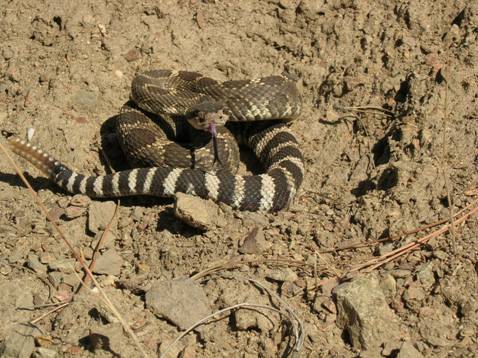Sticking with the desert theme this week – this is the only type of rattlesnake found in the Pacific Northwest. It’s a heavy bodied snake with large dark spots, a triangular shaped head, a distinct eye stripe, and of course a rattle at the end of the tail.
The largest specimen recorded in WA was just about 6 feet long; 2-3 ft is more typical. The “spots” on the back and side merge towards the tail to for dark bands. They occur through lower B.C and the east side of the Cascades in WA, but are more widely distributed in Oregon including the Columbia Gorge and the Willamette Valley. Three subspecies are recognized that represent a wide range of color variation.
In general, poisonous snakes in the U.S. can be recognized by the flat, broad shape of the head and they have vertical pupils rather than round ones (coral snakes the exception) – but that assumes you can get close enough to see their eye clearly! Rattlesnakes are in the family Viparidae – the pit vipers. They have holes, or pits adjacent to their nostrils that are linked to a heat sensing organ, which they use to detect prey. The pits on this rattlesnake in the photo are clearly visible. They prefer small mammals such as ground squirrels, mice, rats, and small rabbits. Youngsters may take reptiles and amphibians.
After hibernation they are on the hunt for a mate and the males may “wrestle” for the attention of female by intertwining their bodies and spiraling upwards. Can’t say I’ve ever seen that. Ahhh – the poison: Rattlesnakes have two fangs through which they inject their prey with a hemotoxic venom – one that travels through the bloodstream and breaks down tissue, causes swelling, and internal bleeding – essentially getting a head start on digestion while disabling the prey. About 7,000 – 8,000 people in the U.S. are bitten by a venomous snake each year but only about 5 die. So the odds are pretty good for you – but the bite can be pretty painful and cause necrosis of tissue – so worth avoiding.
I went to grad school with a guy who grew up in the Allegheny Mountains of West Virginia and when he was 10 he got bit on the thumb by a rattlesnake while he was handling it. His folks told him over and over “Don’t pick up rattlesnakes!” So he hid his wound at dinner, went to bed, was sick for a couple days — and then became a herpetologist.
This photo was taken on another mountain bike ride through the Swakane Wildlife Area in eastern WA, between Wenatchee and Chelan, along the Columbia River. Generally if you leave them alone, they will leave you alone and will give you a rattle to say “heads up!” Though on more than one occasion, in cool weather of early spring, or during a sun spell after a rain storm, I have sat down next to one, leaned back on my hands only to glance over and see one curled up less than a foot away. A slow retreat kept us both happy.
